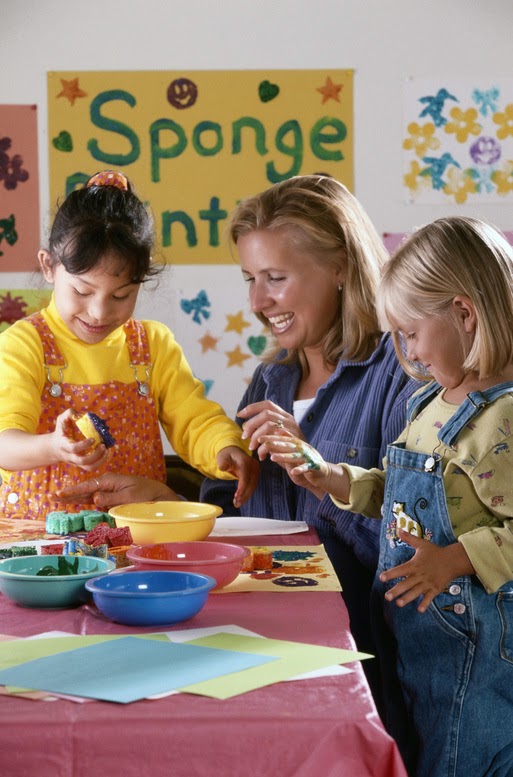 The theme for the 2015 Week of the Young Child™ is Celebrating Our
Youngest Learners! However, the National Association for the Education of Young Children's theme for WOYC is a suggestion
rather than a mandate.
The theme for the 2015 Week of the Young Child™ is Celebrating Our
Youngest Learners! However, the National Association for the Education of Young Children's theme for WOYC is a suggestion
rather than a mandate.Children learn so much as they sing, count, play instruments, bang pots and pans, prepare food with their families, build with blocks, paint (even with water), create art projects, wash dishes, splash in the tub, watch objects sink or float, dig in sand, tend a garden, water plants, jump in leaves and feel the grass between their toes.
 Here are some additional ideas to spark the creative juices in young children from infants to toddlers and preschoolers: http://www.naeyc.org/woyc/activity-resources
Here are some additional ideas to spark the creative juices in young children from infants to toddlers and preschoolers: http://www.naeyc.org/woyc/activity-resources Excel Math lessons are filled with creative ideas to spark the interest of young children and help them succeed in math.
Excel Math lessons are filled with creative ideas to spark the interest of young children and help them succeed in math.Lessons begin with Kindergarten, and a Pre-Kindergarten edition is available for Summer School to help youngsters prepare for the school year.
Activities include sorting, counting and cardinality, creating numbers with various art materials, clapping and stomping, finding patterns, recognizing coins, tracing numbers, and much more.
Take a look at lesson samples in three versions:
Here's a student lesson sheet from Excel Math Kindergarten:
 |
| Excel Math Kindergarten Student Lesson Sheet |
Here are just a few of the reasons these math lessons work so well for young students:
Creative Exercises
Exercises are provided after every five days of lessons.
They are designed to be fun to do and to reinforce the math concepts the students are learning.
Exercises might include coloring by number, following a maze, tracing a path through a number grid, counting by tens in teams, comparing attributes of shapes, finding shapes in the classroom, sorting objects of different lengths and lots more.
Hands-On Resources
Manipulatives (printable resources) are included on the Excel Math Student Lesson Sheets, in the back of the Teacher Edition and online.
Some manipulatives are reproducible masters that the students can use to make 3-D objects, picture cards to sort and classify, visuals and counters to cut apart for math story problems, and lots more.
Using these masters, students begin to add and subtract using Ten Frames, create composite shapes with smaller shapes, form patterns, count objects, decompose numbers, and play math games.
Creative Activities
Activities are included every 6-10 lessons.
These hands-on mini-lessons may reinforce a concept taught a few days before or teach something that is not easily communicated with pencil and paper work.
Activities often involve students moving out of their seats or creating things from craft supplies.
| Kindergarten Exercise from Excel Math |
Exercises are provided after every five days of lessons.
They are designed to be fun to do and to reinforce the math concepts the students are learning.
Exercises might include coloring by number, following a maze, tracing a path through a number grid, counting by tens in teams, comparing attributes of shapes, finding shapes in the classroom, sorting objects of different lengths and lots more.
Manipulatives (printable resources) are included on the Excel Math Student Lesson Sheets, in the back of the Teacher Edition and online.
Some manipulatives are reproducible masters that the students can use to make 3-D objects, picture cards to sort and classify, visuals and counters to cut apart for math story problems, and lots more.
Using these masters, students begin to add and subtract using Ten Frames, create composite shapes with smaller shapes, form patterns, count objects, decompose numbers, and play math games.
Activities are included every 6-10 lessons.
These hands-on mini-lessons may reinforce a concept taught a few days before or teach something that is not easily communicated with pencil and paper work.
Activities often involve students moving out of their seats or creating things from craft supplies.
Excel Math provides lots of opportunities for young children to experience hands-on learning.
Excel Math lessons give teachers the resources they need to help every child succeed and achieve (at high levels) in elementary mathematics.
Questions about how Excel Math lessons work? Leave a comment below.
You may also enjoy these articles:
Financial Awareness for Students


No comments:
Post a Comment
Type your comment here